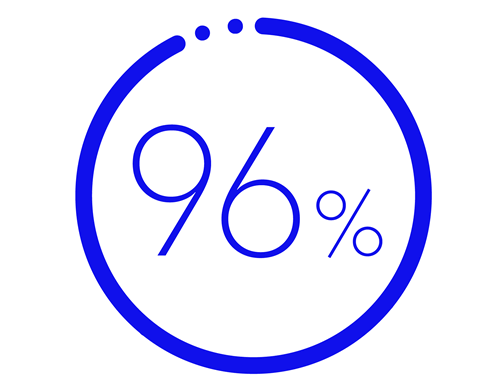
The amount of healthcare data collected daily is massive — and growing exponentially. At the same time, about two-thirds of physicians say they do not have all the healthcare information they need about their patients.¹ This apparent dichotomy means there is a tremendous untapped opportunity to improve how data enables physicians to care for patients. As a healthcare technology leader, Medtronic is in a unique position to bridge this gap, turning data into insights, and insights into actions that address the biggest healthcare challenges of today and tomorrow.
Improving care through data
of U.S. physicians say that easier access to critical information may help save someone's life.
Source: Google/Harris Poll
Healthcare spending per capita in the United States is greater than any other nation,2 and at $4 trillion annually, total U.S. healthcare spending is the highest in the world.3 Yet the United States lags almost all developed nations in key healthcare outcomes, including life expectancy.4 But data has the potential to make a difference.
We are committed to applying data analytics, machine learning, and artificial intelligence to improve healthcare technology globally. And by partnering with health systems in new ways — from acting on population health data to gathering insights through connected technologies — we believe we can help improve experiences for patients and clinicians. With advanced data and analytics, our health system partners get the best of both worlds: greater personalization of care and insights that can be applied broadly for extraordinary outcomes.
The payoff is clear and has sparked our investment in technology to gather and process data.
Here are three ways Medtronic data and insights can improve costs and patient care:
1. Improve treatment through data-enabled devices
Analytical engines embedded in our technologies can have a significant impact on outcomes. Smart devices help patients adapt their own treatment in more targeted and effective ways, or automatically adapt it for them.
Our InPen™ smart insulin pen helps people with type 1 diabetes manage multiple daily injections by tracking insulin doses in real time and offering personalized dose recommendations.
And our cardiac rhythm devices with the AdaptivCRT™ algorithm adjust therapy with minute-by-minute evaluations of a patient’s heart rhythm. They have been shown to reduce the likelihood of 30-day heart failure hospital readmissions,5 reduce the risk of atrial fibrillation,6 and improve patient survival.7

Adapting to patient needs
When we collaborate with health systems to incorporate data from smart devices, insights can lead to better care at scale. The AdaptivCRT™ algorithm provides valuable insight to clinicians and systems beyond just adapting to the patient’s heart rhythm. With Spectrum Health, we worked to combine device and patient data to automate the identification of qualifying readmission events. This allows them to be more efficiently administered under an existing financial accountability program with the Michigan-based health system.
2. Deliver evidence-based insights to clinical teams
Another way we work with health systems is to create better flows of information before, during, and after treatments. With the VitalSync™ system, clinicians can remotely monitor data wherever they are on a hospital network to support both proactive and in-the-moment responses to patient needs. In the OR, the AI-powered Touch Surgery™ Enterprise solution allows surgeons to easily record their case and then access video on a phone or computer. Surgeons can review, share, and discuss insights to identify best practices and accelerate training. With the data captured from video, in the future, AI and machine learning technology can assist in the benchmarking and analysis of variation to help reduce surgical variability.

A new way to address disparities
We know data-driven insights have even greater potential. By collaborating with Mpirik, Vizient and hospitals, we aim to address disparities in care associated with sudden cardiac arrest. Our data shows that many patients medically indicated for devices that can prevent cardiac arrest do not receive them, with people of color and women getting devices at a lower rate than white men.8 Mpirik’s AI platform screens electronic health records at five hospitals to identify patients, regardless of race or gender, who meet the criteria for implantable cardioverter defibrillators or cardiac resynchronization therapy defibrillators. By using real-world data to remove potential bias in decision-making, the collaboration aims to improve care pathways and improve outcomes for all patients.
3. Optimize value with transparency
Data is key to creating value-based healthcare partnerships. By measuring results, our partners can meet their goals for value and outcomes. For that to happen, both providers and Medtronic need to be seeing and working from the same financial and outcomes data.
This type of transparency unlocks new forms of value-based care agreements — like the diabetes partnership between Blue Cross Blue Shield of Minnesota and Medtronic. In the agreement, Medtronic only gets reimbursed in full if data shows that MiniMed™ devices are producing better outcomes. At the same time, Blue Cross committed to offering MiniMed™ pumps as a pharmacy benefit to increase access and lower costs for patients.
We’re entering a golden age of technology. Data is critical to moving us forward.”

Real data, real solutions
The untapped potential of data and insights gives us real and measurable ways to address disparities, personalize care, and more. With healthcare technologies designed to collect and interpret data, we’re working with health systems to improve outcomes and lower costs. And together we are creating a more equitable, smarter future.
- Quest Diagnostics. New study of physicians and health plan executives reveals actions needed to accelerate value-based care. Available at https://newsroom.questdiagnostics.com/2016-06-14-New-Study-of-Physicians-and-Health-Plan-Executives-Reveals-Actions-Needed-to-Accelerate-Value-Based-Care. Accessed on 12.9.2021.
- The World Bank. Current health expenditure per capita. Available at https://data.worldbank.org/indicator/SH.XPD.CHEX.PC.CD. Accessed 12/21/2021.
- Keehan SP, Cuckler GA, Poisal JA. National health expenditure projections, 2019–28: expected rebound in prices drives rising spending growth. Health Aff. Vol. 39, No. 4. April 2020. Available at https://www.healthaffairs.org/doi/full/10.1377/hlthaff.2020.00094. Accessed 12/20/21.
- The Value Journey of Healthcare Data PPT presentation. Source: OECD (2017), Health at a glance 2017: OECD indicators, OECD publishing, Paris. Available at https://doi.org/10.1787/health_glance-2017-en. Accessed on 8/29/2019.
- Starling RC, Krum H, Bril S, et al. Impact of a novel adaptive optimization algorithm on 30-day readmissions: Evidence from the adaptive CRT Trial. JACC Heart Fail. July 2015;3(7):565–572.
- Birnie D, Hudnall H, Lemke B, et al. Continuous optimization of cardiac resynchronization therapy reduces atrial fibrillation in heart failure patients: Results of the Adaptive Cardiac Resynchronization Therapy Trial. Heart Rhythm. December 2017;14(12):1820–1825.
- Singh JP, et al. Improved survival with dynamic optimization of CRT pacing using AdaptivCRT algorithm: Analysis of real-world patient data. Presented at HRS 2018 (Abstract B-AB37 -06).
- Curtis AB, et al. Real-world Assessment of Disparities in the Use of Guideline-directed Defibrillator Therapy. Presented at HRS 2019; San Francisco, CA.
Explore topics:
-
 Healthcare technology
Healthcare technology -
 Healthcare technology
Healthcare technologyCould personalized healthcare reinvent medicine?
-
 Healthcare technology
Healthcare technologyImproving people’s lives with groundbreaking tech
-
 Healthcare technology
Healthcare technologyOur bold ambition
-
 Healthcare technology
Healthcare technologyOur legacy of life-transforming health tech
-
 Healthcare technology
Healthcare technologySmall health tech, big benefits

